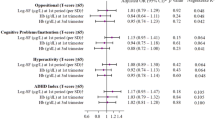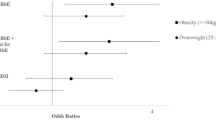Abstract
Inflammation provides a substrate for mechanisms that underlie the association of maternal diet during pregnancy with Attention Deficit-Hyperactivity Disorder (ADHD) symptoms in childhood. However, no previous study has quantified the proinflammatory potential of maternal diet as a risk factor for ADHD. Thus, we evaluated the association of maternal dietary inflammatory index (DII®) scores during pregnancy with ADHD symptoms in 4-year-old children born in two Mediterranean regions. We analyzed data from two population-based birth cohort studies—INMA (Environment and Childhood) four subcohorts in Spain (N = 2097), and RHEA study in Crete (Greece) (N = 444). The DII score of maternal diet was calculated based on validated food frequency questionnaires completed during pregnancy (12th and/or 32nd week of gestation). ADHD symptoms were assessed by ADHD-DSM-IV in INMA cohort and by ADHDT test in RHEA cohort, with questionnaires filled-out by teachers and parents, respectively. The associations between maternal DII and ADHD symptoms were analysed using multivariable-adjusted zero-inflated negative binomial regression models in each cohort study separately. Meta-analysis was conducted to combine data across the cohorts for fitting within one model. The DII was significantly higher in RHEA (RHEA = 2.09 [1.94, 2.24]) in comparison to INMA subcohorts (Asturias = − 1.52 [− 1.67, − 1.38]; Gipuzkoa = − 1.48 [− 1.64, − 1.33]; Sabadell = − 0.95 [− 1.07, − 0.83]; Valencia = − 0.76 [− 0.90, − 0.62]). Statistically significant reduced risk of inattention symptomatology (OR = 0.86; CI 95% = 0.77–0.96), hyperactivity symptomatology (OR = 0.82; CI 95% = 0.72–0.92) and total ADHD symptomatology (OR = 0.82; CI 95% = − 0.72 to 0.93) were observed with increased maternal DII in boys. No statistically significant associations were observed in girls between maternal DII and inattention, hyperactivity and total ADHD symptomatology. We found reduced risk of ADHD symptomatology with increased DII only in boys. This relationship requires further exploration in other settings.


Similar content being viewed by others
References
Amador-Campos JA, Forns-Santacana M, Guàrdia-Olmos J, Peró-Cebollero M (2006) DSM-IV attention deficit hyperactivity disorder symptoms: agreement between informants in prevalence and factor structure at different ages. J Psychopathol Behav Assess 28:23–32
Amakye WK, Zhang Z, Wei Y, Shivappa N, Hebert JR, Wang J, Su Y, Mao L (2018) The relationship between dietary inflammatory index (DII) and muscle mass and strength in Chinese children aged 6–9 years. Asia Pac J Clin Nutr 27:1315–1324. https://doi.org/10.6133/apjcn.201811_27(6).0019
American Psychiatric Association (2000) Diagnostic and statistical manual of mental disorders, 4th edn. American Psychiatric Association, Washington, DC
Andersen CH, Thomsen PH, Nohr EA, Lemcke S (2018) Maternal body mass index before pregnancy as a risk factor for ADHD and autism in children. Eur Child Adolesc Psychiatry 27:139–148. https://doi.org/10.1007/s00787-017-1027-6
Anjos T, Altmäe S, Emmett P, Tiemeier H, Closa-Monasterolo R, Luque V, Wiseman S, Pérez-García M, Lattka E, Demmelmair H, Egan B, Straub N, Szajewska H, Evans J, Horton C, Paus T, Isaacs E, van Klinken JW, Koletzko B, Campoy C (2013) Nutrition and neurodevelopment in children: focus on NUTRIMENTHE project. Eur J Nutr 52:1825–1842. https://doi.org/10.1007/s00394-013-0560-4
Aslani Z, Qorbani M, Hébert JR, Shivappa N, Motlagh ME, Asayesh H, Mahdavi-Gorabi A, Kelishadi R (2019) Association of dietary inflammatory index with anthropometric indices in children and adolescents: the weight disorder survey of the childhood and adolescence surveillance and prevention of adult non- communicable disease (CASPIAN)-IV study. Br J Nutr 121:340–350. https://doi.org/10.1017/S0007114518003240
Atladottir HO, Gyllenberg D, Langridge A, Sandin S, Hansen SN, Leonard H, Gissler M, Reichenberg A, Schendel DE, Bourke J, Hultman CM, Grice DE, Buxbaum JD, Parner ET (2015) The increasing prevalence of reported diagnoses of childhood psychiatric disorders: a descriptive multinational comparison. Eur Child Adolesc Psychiatry 24:173–183. https://doi.org/10.1007/s00787-014-0553-8
Bilbo SD, Tsang V (2010) Enduring consequences of maternal obesity for brain inflammation and behavior of offspring. FASEB J 24:2104–2115
Bordoni A, Danesi F, Dardevet D, Dupont D, Fernandez AS, Gille D, Nunes dos Santos C, Pinto P, Re R, Rémond D, Shahar DR, Vergères G (2017) Dairy products and inflammation: a review of the clinical evidence. Crit Rev Food Sci Nutr 57(12):2497–2525. https://doi.org/10.1080/10408398.2014.967385
Buss C, Entringer S, Poggi Davis E, Hobel CJ, Swanson JM, Wadhwa PD, Sandman CA (2012) Impaired executive function mediates the association between maternal pre-pregnancy body mass index and child ADHD symptoms. PLoS ONE 7:e37758. https://doi.org/10.1371/journal.pone.0037758
Chatzi L, Melaki V, Sarri K et al (2011) Dietary patterns during pregnancy and the risk of postpartum depression: the mother–child ‘Rhea’ cohort in Crete, Greece. Public Health Nutr 14:1663–1670. https://doi.org/10.1017/S1368980010003629
Chatzi L, Garcia R, Roumeliotaki T, Basterrechea M, Begiristain H, Iñiguez C, Vioque J, Kogevinas M, Sunyer J (2013) Mediterranean diet adherence during pregnancy and risk of wheeze and eczema in the first year of life: INMA (Spain) and RHEA (Greece) mother–child cohort studies. Br J Nutr 110:2058–2068. https://doi.org/10.1017/S0007114513001426
Chatzi L, Leventakou V, Vafeiadi M, Koutra K, Roumeliotaki T, Chalkiadaki G, Karachaliou M, Daraki V, Kyriklaki A, Kampouri M, Fthenou E, Sarri K, Vassilaki M, Fasoulaki M, Bitsios P, Koutis A, Stephanou EG, Kogevinas M (2017) Cohort Profile: The Mother-Child Cohort in Crete, Greece (Rhea Study). Int J Epidemiol 46:1392–1393. https://doi.org/10.1093/ije/dyx084
Chen Q, Sjolander A, Langstrom N, Rodriguez A, Serlachius E, D’Onofrio BM et al (2014) Maternal pre-pregnancy body mass index and offspring attention deficit hyperactivity disorder: a population-based cohort study usinga sibling-comparison design. Int J Epidemiol 43:83–90. https://doi.org/10.1093/ije/dyt152
Coheley LM, Shivappa N, Hebert JR, Lewis RD (2019) Dietary inflammatory index® and cortical bone outcomes in healthy adolescent children. Osteoporos Int. https://doi.org/10.1007/s00198-019-04946-3
Cortese S, Vincenzi B (2011) Obesity and ADHD: Clinical and Neurobiological Implications. In: Stanford C, Tannock R (Eds) Behavioral Neuroscience of Attention Deficit Hyperactivity Disorder and Its Treatment. Current Topics in Behavioral Neurosciences, vol 9. Springer, Berlin, Heidelberg.
DeCapo M, Thompson JR, Dunn G, Sullivan EL (2019) Perinatal nutrition and programmed risk for neuropsychiatric disorders: a focus on animal models. Biol Psychiat 85:122–134. https://doi.org/10.1016/j.biopsych.2018.08.006
De Onis M, Onyango AW, Borghi E, Siyam A, Nishida C, Siekmann J (2007) Development of a WHO growth reference for school-aged children and adolescents. Bull World Health Organ 85:660–667
Edlow AG (2017) Maternal obesity and neurodevelopmental and psychiatric disorders in offspring. Prenat Diagn 37:95–110. https://doi.org/10.1002/pd.4932
Elovitz MA, Brown AG, Breen K et al (2011) Intrauterine inflammation, insufficient to induce parturition, still evokes fetal and neonatal brain injury. Int J Dev Neurosci 29:663–671
Fernández-Barrés S, Romaguera D, Valvi D, Martínez D, Vioque J, Navarrete- Muñoz EM, Amiano P, Gonzalez-Palacios S, Guxens M, Pereda E, Riaño I, Tardón A, Iñiguez C, Arija V, Sunyer J, Vrijheid M (2016) Mediterraneandietary pattern in pregnant women and offspring risk of overweight and abdominal obesity in early childhood: the INMA birth cohort study. Pediatr Obesity 11(6):491–499. https://doi.org/10.1111/ijpo.12092
Gershon J, Gershon J (2002) A meta-analytic review of gender differences in ADHD. J Atten Disord 5(3):143–154. https://doi.org/10.1177/108705470200500302
Gilliam JE (1995) Attention-deficit hyperactivity disorder test. Pro-Ed, Austin
Gomez R (2007) Testing gender differential item functioning for ordinal and binary scored parent rated ADHD symptoms. Personal Individ Differ 42:733–742. https://doi.org/10.1016/j.paid.2006.08.011
Guxens M, Ballester F, Espada M et al (2012) Cohort profile: the INMA–INfancia y Medio Ambiente-(Environment and Childhood) project. Int J Epidemiol 41:930–940. https://doi.org/10.1093/ije/dyr054
Han YY, Forno E, Shivappa N, Wirth MD, Hébert JR, Celedón JC (2018) The dietary inflammatory index and current wheeze among children and adults in the United States. J Allergy Clin Immunol Pract 6:834–841. https://doi.org/10.1016/j.jaip.2017.12.029
Maniadaki K, Kakouros E (2002) Translation and adaptation of the Attention Deficit HyperactivityDisorderTest (ADHDT; Giliam, 1995). In: Stalikas A, Triliva S, Roussi P (eds) The psychometric Instruments in Greece. Ellinika Grammata, Athens, pp 102–103
Park JH, Seo JH, Hong YS, Kim YM, Kang JW, Yoo JH, Chueh HW, Lee JH, Kwak MJ, Kim J, Woo HD, Kim DW, Bang YR, Choe BM (2016) Blood lead concentrations and attention deficit hyperactivity disorder in Korean children: a hospital-based case control study. BMC Pediatr. https://doi.org/10.1186/s12887-016-0696-5
Polanczyk G, Rohde LA (2007) Epidemiology of attention-deficit/hyperactivity disorder across the lifespan. Curr Opin Psychiatry 20:386–392. https://doi.org/10.1097/YCO.0b013e3281568d7a
Pugh SJ, Hutcheon JA, Richardson GA, Brooks MM, Himes KP, Day NL, Bodnar LM (2016) Gestational weight gain, prepregnancy body mass index and offspring attention-deficit hyperactivity disorder symptoms and behaviour at age 10. BJOG 123:2094–2103. https://doi.org/10.1111/1471-0528.13909
Rodriguez A, Miettunen J, Henriksen TB, Olsen J, Obel C, Taanila A, Ebeling H, Linnet KM, Moilanen I, Jarvelin MR (2008) Maternal adiposity prior to pregnancy is associated with ADHD symptoms in offspring: evidence from three prospective pregnancy cohorts. Int J Obes 32:550–557. https://doi.org/10.1038/sj.ijo.0803741
Rodriguez A (2010) Maternal pre-pregnancy obesity and risk for inattention and negative emotionality in children. J Child Psychol Psychiatry 51:134–143. https://doi.org/10.1111/j.1469-7610.2009.02133.x
Rutter M, Beckett C, Castle J, Colvert E, Kreppner J, Mehta M, Stevens S, Sonuga-Barke E (2007) Effects of profound early institutional deprivation: an overview of findings from a UK longitudinal study of Romanian adoptees. Eur J Dev Psychol 4:332–350
Shivappa N, Steck SE, Hurley TG, Hussey JR, Hebert JR (2014) Designing and developing a literature-derived population-based dietary inflammatory index. Public Health Nutr 17(6):1689–1696
Spencer TJ, Biederman J, Mick E (2007) Attention-deficit/hyperactivity disorder: diagnosis, lifespan, comorbidities, and neurobiology. J Pediatr Psychol 32:631–642. https://doi.org/10.1093/jpepsy/jsm005
Steck S, Shivappa N, Tabung F, Harmon EB, Wirth M, Hurley T, Hebert J (2014) The dietary inflammatory index: a new tool for assessing diet quality based on inflammatory potential. Digest 49:1–9
Thapar A, Cooper M, Eyre O, Langley K (2013) Practitioner review: What have we learnt about the causes of ADHD? J Child Psychol Psychiatry 54:3–16. https://doi.org/10.1111/j.1469-7610.2012.02611.x
Thapar A, Cooper M, Jefferies R, Stergiakouli E (2012) What causes attention deficit hyperactivity disorder? Arch Dis Child 97:260–265. https://doi.org/10.1136/archdischild-2011-300482
Vilor-Tejedor N, Alemany S, Forns J, Cáceres A, Murcia M, Maciá D, Pujol J, Sunyer J, González JR (2016) Assessment of susceptibility risk factors for ADHD in imaging genetic studies. J Atten Disord. https://doi.org/10.1177/1087054716664408
Vioque J, Navarrete-Muñoz EM, Gimenez-Monzó D, García-de-la-Hera M, Granado F, Young IS, Ramón R, Ballester F, Murcia M, RebagliatoIñiguez MC (2013) Reproducibility and validity of a food frequency questionnaire among pregnant women in a Mediterranean area. Nutr J 12:26. https://doi.org/10.1186/1475-2891-12-26
Acknowledgements
The authors would particularly like to thank all the cohort participants for their generous collaboration. A full roster of the INMA Project Investigators can be found at http://www.proyectoinma.org/presentacioninma/listadoinvestigadores/en_listadonvestigadores.html[V1] and of the Rhea project Investigators at http://www.rhea.gr/en/about-rhea/the-rhea-team/.
Funding
This study was funded by grants from Spanish Ministry of Health-Instituto de Salud Carlos III (Red INMA G03/176, CB06/02/0041, FIS-PI041436, FIS- PI081151, FIS- PI042018, FISPI09/02311, FIS-PI06/0867, FIS-PS09/00090, FIS-FEDER PI11/1007 FIS-FEDER 03/1615, 04/1509, 04/1112, 04/1931, 05/1079, 05/1052, 06/1213, 07/0314, and 09/02647), Generalitat de Catalunya- CIRIT 1999SGR 00241, Conselleria de Sanitat Generalitat Valenciana, FISS-FEDER PI13/02429, FISS-FEDER PI18/00909, Universidad de Oviedo, Obra Social Cajastur-LIBERBANK, Department of Health of the Basque Government (2005111093 and 2009111069), the Provincial Government of Gipuzkoa (DFG06/004 and DFG08/001), Fundación Roger Torné, and Alicia Koplowitz Foundation 2017. Drs. Valvi and Chatzi are currently receiving funding from the National Institute of Environmental Health Sciences (R21 ES029328, R21 ES028903).
Author information
Authors and Affiliations
Corresponding author
Ethics declarations
Conflict of interest
Dr. James R. Hébert owns controlling interest in Connecting Health Innovations LLC (CHI), a company planning to license the right to his invention of the dietary inflammatory index (DII) from the University of South Carolina to develop computer and smart phone applications for patient counselling and dietary intervention in clinical settings. Dr. Nitin Shivappa is an employee of CHI. All other authors declare that they have no conflict of interest.
Ethical approval
The INMA Project was approved by the Hospital Ethics Committees in the participating regions and hospitals. The RHEA study was approved by the ethical committee of the University Hospital in Heraklion, Crete (Greece).
Supplementary Information
Below is the link to the electronic supplementary material.
Rights and permissions
About this article
Cite this article
Lertxundi, N., Molinuevo, A., Valvi, D. et al. Dietary inflammatory index of mothers during pregnancy and Attention Deficit-Hyperactivity Disorder symptoms in the child at preschool age: a prospective investigation in the INMA and RHEA cohorts. Eur Child Adolesc Psychiatry 31, 615–624 (2022). https://doi.org/10.1007/s00787-020-01705-2
Received:
Accepted:
Published:
Issue Date:
DOI: https://doi.org/10.1007/s00787-020-01705-2




